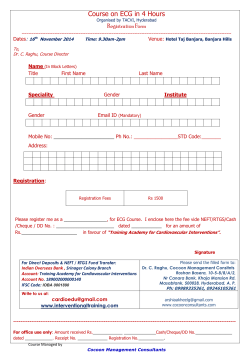
Brochure for Geotechnical Aspects of EE 2015
Registration Form Name: Mr./Ms./Dr……………………………. Designation: …………………………………. Organization: ……………………................... ……………………………………………….. Phone: ………………… Address for Communication: ……………………………………………….. ……………………………………………….. …………..Phone: …………………………… E-mail: ………………………………………. Registration Fee The course fee is Rs.6,000/- (Six Thousand Only) per participant for professionals and Rs.4,500 (Four Thousand Five Hundred Only) for students. Registration fee includes course material, tea & working lunches. The fee is payable in advance by a crossed draft in favor of IIIT Hyderabad, payable at Hyderabad. Accommodation can be arranged on first come first serve basis in the campus and hotels. Accommodation charges are not included in the registration fee. SHORT COURSE ON GEOTECHNICAL ASPECTS OF EARTHQUAKE ENGINEERING 23– 25th July, 2015 Venue: IIIT Hyderabad *Please note that the number of seats are limited to 30. Fax: ………………………………………….. Address for Correspondence D.D/Cheque Details: I enclose herewith Demand Draft/Cheque no……………………...dated.....................for Rs. .................................. payable to IIIT Hyderabad. Note: D.D/Cheque must be returned to the coordinator D. Neelima Satyam (Co-ordinator) Assistant Professor Geotechnical Engineering Laboratory International Institute of Information Technology Hyderabad Organized by Gachibowli, Hyderabad– 500 032, India. Ph: 040-6653 1220/1165;09441940196; 09963813231 Accommodation required: Yes/No (On Payment Basis) Fax::040-6653 1413 Email: gte@iiit.ac.in Date: Signature Geotechnical Engineering Laboratory International Institute of Information Technology Hyderabad Gachibowli, Hyderabad –500 032, India About the Course India has experienced the most disastrous earthquakes like Assam 1897(M=8.7), Kangra 1905 (M=8.6), Bihar-Nepal 1934 (M=8.4), Assam-Tibet 1950 (M=8.7), Uttarkashi 1991 (M=6.5), Latur 1993 (M=6.4), Jabalpur 1997 (M=6.0), Chamoli 1999 (M = 6.8), Bhuj 2001 (M= 7.6), Kashmir 2005 (M=7.4), Sikkim 2011 (M=6.9) and Nepal 2015 (M=7.9) in the recent past. The large and rapidly growing urban seismic risk, particularly in developing countries like India is a problem that needs to be quickly solved. Urbanization is rapidly increasing in every city in India. Huge infrastructure developmental plans have been laid in all these cities which are demanding trained structural engineers/ consultants in a large number. It is observed that large concentration of damage in specific areas during an earthquake is due to site dependent factors related to surface geological conditions and local soil altering seismic motion. \To reduce the gap and transfer the knowledge many workshops, seminars, short courses and technical lectures were conducted by IIIT-H, to bring the awareness amongst the professional engineers. The course is designed to have a broader review on the various aspects of Geotechnical Engineering interlinked with Earthquake Engineering. Each of these lectures during this short course addresses specific issues from the beginning to end (from engineering seismology to Earthquake resistant design). The course lectures covers both fundamentals and applications including hands-on experience in seismic design of sub-structures. Who Should Participate? This short course is planned for design and construction engineers, project managers, faculty members and students. About IIIT-H and Geotechnical Laboratory International Institute of Information Technology, Hyderabad is an autonomous, self-supporting research institution established in 1998 with seed support from the Government of Andhra Pradesh. Major goal of IIIT-H is to impart a uniquely broad and interdisciplinary IT education of the highest academic quality. This is achieved through an integrated curriculum that consists of a highly diverse set of IT courses, interdisciplinary IT research projects, day-to-day interaction with industry, preparation in entrepreneurship and personality development courses. Geotechnical Engineering research laboratory addresses a wide range of problems posed by the spatial variability and complex material properties of soils and rocks. Geotechnical engineers design dams, embankments, cuts, foundations, retaining walls, anchors, tunnels, and all other structures directly interacting with the subsoil, both onshore and offshore. Risk assessment associated to geohazards such as landslides or earthquakes is another responsibility of geotechnical engineers. Geotechnical engineering is based on soil and rock mechanics and testing. Analytical methods play a major role in today’s design but are more and more replaced by numerical methods. Geotechnical Engineering Laboratory is involved with research activities in soil testing, soil modeling, numerical analyses, slope stability including progressive failure. For more details, visit www.gte.iiit.ac.in Course Faculty Dr. Neelima Satyam. D, Assistant Professor, IIIT H Also experts from industry and academics are invited . Lecture Topics Overview of Earthquake Engineering Dynamic Soil Properties Geotechnical Testing Methods Seismic Hazard Analysis Ground Response Analysis Local Site Effects Assessment of Liquefaction Hazard Seismic Design of Foundations (Shallow and Deep). Seismic Design of Retaining Walls Ground Improvement Techniques
© Copyright 2025










